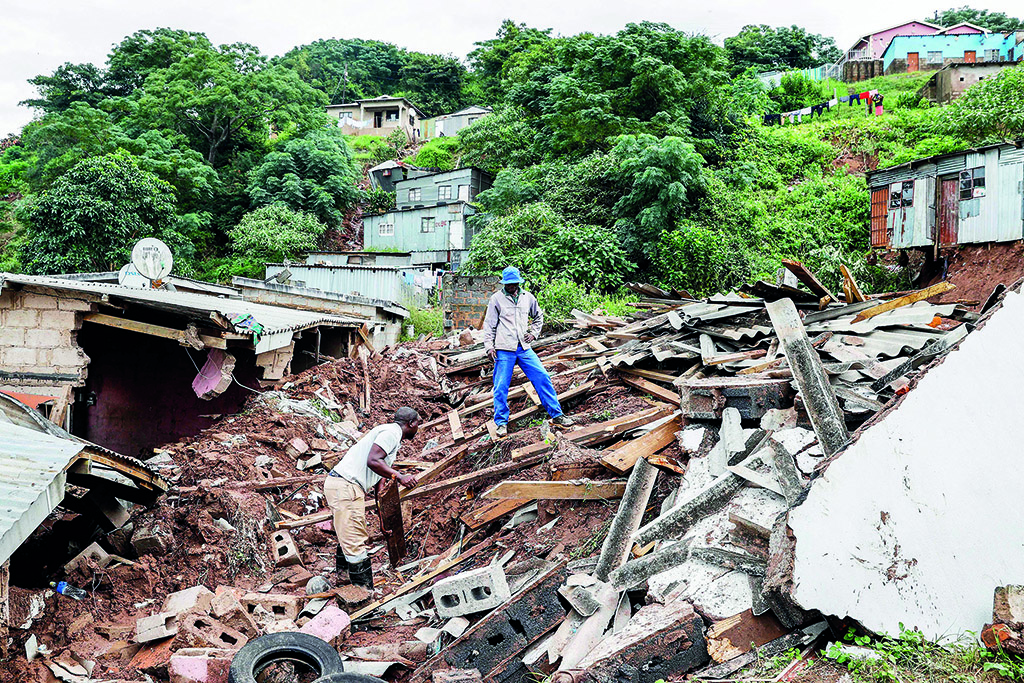DURBAN: Devastating floods killed 259 in the South African city of Durban and surrounding areas, a senior government official said Wednesday, after hillsides were washed away, homes collapsed, and more people were still feared missing. The heaviest rains in 60 years pummeled Durban's municipality, known as eThekwini. According to an AFP tally, the storm is the deadliest on record in South Africa.
"At the moment the confirmed figures of people that have perished during this disaster is 259, across the KwaZulu-Natal (KZN) province," Nonala Ndlovu, spokeswoman for the provincial disaster management department told AFP. President Cyril Ramaphosa has described the floods as a "catastrophe" and a "calamity".
"Bridges have collapsed. Roads have collapsed. People have died... this is a catastrophe of enormous proportions," he said, addressing a local community after inspecting the damage from the floods that have claimed 259 lives. The search for missing persons is still going on, said Ramaphosa, promising to "spare nothing" in dealing with the disaster.
"This disaster is part of climate change. We no longer can postpone what we need to do... to deal with climate change. "It is here, and our disaster management capability needs to be at a higher level," said the president. Earlier the provincial health chief Nomagugu Simelane-Zulu had expressed their "biggest worry" about the huge toll telling eNCA television that "mortuaries are under a bit of pressure, however we are coping".
The United Methodist Church in the township of Clermont was reduced to a pile of rubble. Four children from a local family died when a wall collapsed on them. Other homes hung precariously to the hillside, miraculously still intact after much of the ground underneath them washed away in mudslides. The storm forced sub-Saharan Africa's most important port to halt operations, as a main access road suffered heavy damage.
Shipping containers were tossed about, washed into mountains of metal. Sections of other roads were washed away, leaving behind gashes in the earth bigger than large trucks. "We see such tragedies hitting other countries like Mozambique, Zimbabwe, but now we are the affected ones," Ramaphosa said as he met with grieving families near the ruins of the church.
South Africa's neighbors suffer such natural disasters from tropical storms almost every year, but Africa's most industrialized country is largely shielded from the storms that form over the Indian Ocean. These rains were not tropical, but rather caused by a weather system called a cut-off low that had brought rain and cold weather to much of the country. When storms reached the warmer and more humid climate in Durban's KZN province, even more rain poured down.
450mm in 48 hours
"Some parts on KZN have received more than 450 millimeters in the last 48 hours," said Tawana Dipuo, a forecaster at the national weather service-nearly half of Durban's annual rainfall of 1,009 mm. Rain continued in parts of the city on Wednesday afternoon, and a flood warning was issued for the neighboring province of Eastern Cape.
The storm struck as Durban had barely recovered from deadly riots last July which claimed more than 350 lives, in South Africa's worst unrest since the end of apartheid. The national police force deployed 300 extra officers to the region, as the air force sent planes to help with the rescue operations.
Days of driving rain flooded several areas, smashed houses and ravaged infrastructure across the city, while landslides forced train services to be suspended across the province. The rains flooded highways to such depths that only the tops of traffic lights poked out, resembling submarine periscopes. Torrents tore several bridges apart, submerged cars and collapsed houses. A fuel tanker floated at sea after being swept off the road.
More than 6,000 homes were damaged. After TV footage showed people stealing from shipping containers, the provincial government condemned "reports of the looting of containers" during the flooding. Southern parts of the country are bearing the brunt of climate change-suffering recurrent and worsening torrential rains and flooding. Floods killed 140 people in 1995.- AFP


